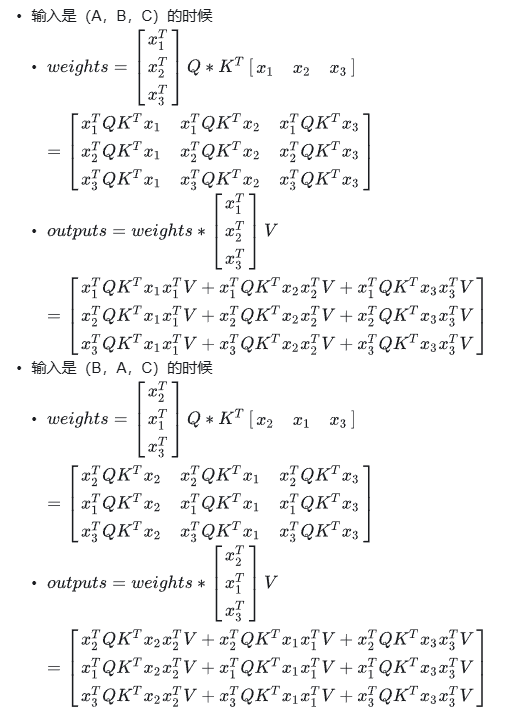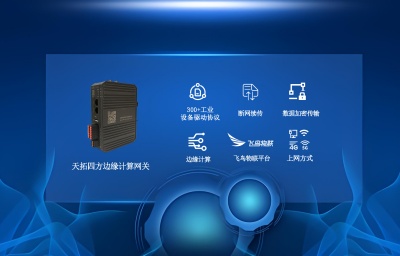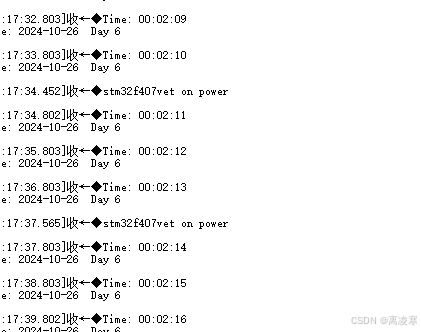最近这一两周看到不少互联网公司都已经开始秋招发放Offer。
不同以往的是,当前职场环境已不再是那个双向奔赴时代了。求职者在变多,HC 在变少,岗位要求还更高了。
最近,我们又陆续整理了很多大厂的面试题,帮助一些球友解惑答疑,分享技术面试中的那些弯弯绕绕。
- 《大模型面试宝典》(2024版) 正式发布!
喜欢本文记得收藏、关注、点赞。更多实战和面试交流,文末加入我们
技术交流

本文基于 llama 模型的源码,学习相对位置编码的实现方法,本文不细究绝对位置编码和相对位置编码的数学原理。
大模型新人在学习中容易困惑的几个问题:
-
为什么一定要在 transformer 中使用位置编码?
-
相对位置编码在 llama 中是怎么实现的?
-
大模型的超长文本预测和位置编码有什么关系?
01 为什么需要位置编码
很多初学者都会读到这样一句话:transformer 使用位置编码的原因是它不具备位置信息。大家都只把这句话当作公理,却很少思考这句话到底是什么意思?
这句话的意思是,如果没有位置编码,那么 “床前明月”、“前床明月”、“前明床月” 这几个输入,会预测出完全一样的文本。
也就是说,不管你输入的 prompt 顺序是什么,只要 prompt 的文本是相同的,那么模型 decode 的文本就只取决于 prompt 的最后一个 token。
import torch
from torch import nn
import math
batch = 1
dim = 10
num_head = 2
embedding = nn.Embedding(5, dim)
q_matrix = nn.Linear(dim, dim, bias=False)
k_matrix = nn.Linear(dim, dim, bias=False)
v_matrix = nn.Linear(dim, dim, bias=False)
x = embedding(torch.tensor([1,2,3])).unsqueeze(0)
y = embedding(torch.tensor([2,1,3])).unsqueeze(0)
def attention(input):
q = q_matrix(input).view(batch, -1, num_head, dim // num_head).transpose(1, 2)
k = k_matrix(input).view(batch, -1, num_head, dim // num_head).transpose(1, 2)
v = v_matrix(input).view(batch, -1, num_head, dim // num_head).transpose(1, 2)
attn_weights = torch.matmul(q, k.transpose(2, 3)) / math.sqrt(dim // num_head)
attn_weights = nn.functional.softmax(attn_weights, dim=-1)
outputs = torch.matmul(attn_weights, v).transpose(1, 2).reshape(1, len([1,2,3]), dim)
print(outputs)
attention(x)
attention(y)
执行上面的代码会发现,虽然 x 和 y 交换了第一个 token 和第二个 token 的输入顺序,但是第三个 token 的计算结果完全没有发生改变,那么模型预测第四个 token 时,便会得到相同的结果。
如果有读者对矩阵运算感到混淆的话,可以看看下面的简单推导:

可以看出,当第一个 token 与第二个 token 交换顺序后,模型输出矩阵的第一维和第二维也交换了顺序,但输出的值完全没有变化。
第三个 token 的输出结果也是完全没有受到影响,这也就是前面说的:如果没有位置编码,模型 decode 的文本就只取决于 prompt 的最后一个 token。
不过需要注意的是,由于 attention_mask 的存在(前置位 token 看不到后置位 token),所以即使不加位置编码,transformer 的输出还是会受到 token 的位置影响。
02 相对位置编码的实现
我们以 modeling_llama.py 的源码为例,来学习相对位置编码的实现方法。
class LlamaRotaryEmbedding(torch.nn.Module):
def __init__(self, dim, max_position_embeddings=2048, base=10000, device=None):
super().__init__()
inv_freq = 1.0 / (base ** (torch.arange(0, dim, 2).float().to(device) / dim))
self.register_buffer("inv_freq", inv_freq)
# Build here to make `torch.jit.trace` work.
self.max_seq_len_cached = max_position_embeddings
t = torch.arange(self.max_seq_len_cached, device=self.inv_freq.device, dtype=self.inv_freq.dtype)
freqs = torch.einsum("i,j->ij", t, self.inv_freq)
# Different from paper, but it uses a different permutation in order to obtain the same calculation
emb = torch.cat((freqs, freqs), dim=-1)
self.register_buffer("cos_cached", emb.cos()[None, None, :, :], persistent=False)
self.register_buffer("sin_cached", emb.sin()[None, None, :, :], persistent=False)
def forward(self, x, seq_len=None):
# x: [bs, num_attention_heads, seq_len, head_size]
# This `if` block is unlikely to be run after we build sin/cos in `__init__`. Keep the logic here just in case.
if seq_len > self.max_seq_len_cached:
self.max_seq_len_cached = seq_len
t = torch.arange(self.max_seq_len_cached, device=x.device, dtype=self.inv_freq.dtype)
freqs = torch.einsum("i,j->ij", t, self.inv_freq)
# Different from paper, but it uses a different permutation in order to obtain the same calculation
emb = torch.cat((freqs, freqs), dim=-1).to(x.device)
self.register_buffer("cos_cached", emb.cos()[None, None, :, :], persistent=False)
self.register_buffer("sin_cached", emb.sin()[None, None, :, :], persistent=False)
return (
self.cos_cached[:, :, :seq_len, ...].to(dtype=x.dtype),
self.sin_cached[:, :, :seq_len, ...].to(dtype=x.dtype),
)
def rotate_half(x):
"""Rotates half the hidden dims of the input."""
x1 = x[..., : x.shape[-1] // 2]
x2 = x[..., x.shape[-1] // 2 :]
return torch.cat((-x2, x1), dim=-1)
def apply_rotary_pos_emb(q, k, cos, sin, position_ids):
# The first two dimensions of cos and sin are always 1, so we can `squeeze` them.
cos = cos.squeeze(1).squeeze(0) # [seq_len, dim]
sin = sin.squeeze(1).squeeze(0) # [seq_len, dim]
cos = cos[position_ids].unsqueeze(1) # [bs, 1, seq_len, dim]
sin = sin[position_ids].unsqueeze(1) # [bs, 1, seq_len, dim]
q_embed = (q * cos) + (rotate_half(q) * sin)
k_embed = (k * cos) + (rotate_half(k) * sin)
return q_embed, k_embed
相对位置编码在 attention 中的应用方法如下:
self.rotary_emb = LlamaRotaryEmbedding(self.head_dim, max_position_embeddings=self.max_position_embeddings)
cos, sin = self.rotary_emb(value_states, seq_len=kv_seq_len)
query_states, key_states = apply_rotary_pos_emb(query_states, key_states, cos, sin, position_ids)
if past_key_value is not None:
# reuse k, v, self_attention
key_states = torch.cat([past_key_value[0], key_states], dim=1)
value_states = torch.cat([past_key_value[1], value_states], dim=1)
根据 value_states 矩阵的形状去调取 cos 和 sin 两个 tensor, cos 与 sin 的维度均是 batch_size * head_num * seq_len * head_dim;
利用 apply_rotary_pos_emb 去修改 query_states 和 key_states 两个 tensor,得到新的 q,k 矩阵
需要注意的是,在解码时,position_ids 的长度是和输入 token 的长度保持一致的,prompt 是 4 个 token 的话。
第一次解码时,position_ids: tensor([[0, 1, 2, 3]], device=‘cuda:0’),q 矩阵与 k 矩阵的相对位置编码信息通过 apply_rotary_pos_emb() 获得;
第二次解码时,position_ids: tensor([[4]], device=‘cuda:0’),当前 token 的相对位置编码信息通过 apply_rotary_pos_emb() 获得。
前 4 个 token 的相对位置编码信息则是通过 key_states = torch.cat([past_key_value[0], key_states], dim=1) 集成到 k 矩阵中;
……
……
以上代码的公式,均可以从苏神原文中找到。
这些代码可以从 llama 模型中剥离出来直接执行,如果感到困惑,可以像下面一样,将 apply_rotary_pos_emb() 的整个过程给 print 出来观察一下:
head_num, head_dim, kv_seq_len = 8, 20, 5
position_ids = torch.tensor([[0, 1, 2, 3, 4]])
query_states = torch.randn(1, head_dim, kv_seq_len, head_dim)
key_states = torch.randn(1, head_dim, kv_seq_len, head_dim)
value_states = torch.randn(1, head_dim, kv_seq_len, head_dim)
rotary_emb = LlamaRotaryEmbedding(head_dim)
cos, sin = rotary_emb(value_states, seq_len=kv_seq_len)
print(cos, sin)
query_states, key_states = apply_rotary_pos_emb(query_states, key_states, cos, sin, position_ids)
03 位置编码与长度外推
长度外推指的是,大模型在训练的只见过长度为 X 的文本,但在实际应用时却有如下情况:

我们假设 X 的取值为 4096,那么也就意味着,模型自始至终没有见到过 pos_id >= 4096 的位置编码,进而导致模型的预测结果完全不可控。
因此,解决长度外推问题的关键便是如何让模型见到比训练文本更长的位置编码。

以上关于文本外推的介绍均是比较大白话的理解,只是为了强调位置编码很重要这一观点。



















